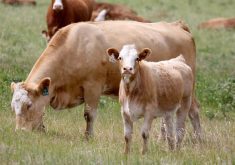Researchers look for the most effective and inexpensive ways cattle producers can select heifers for natural insemination
Breeding cattle for the commercial market can be a real crap shoot.
A lot of research has gone into the fertility of bulls, given their genetic importance.
However, researchers at Lakeland College are trying to offer farmers deeper insight into their breeding programs by looking at the predictive analysis of heifers.
Through the Precision Ranching for Improved Reproductive and Grazing Efficiencies research project, researchers are trying to find the most effective and inexpensive ways farmers can select heifers for natural insemination.
Read Also

More work wanted on removing red tape
REGINA — Canadian farmers risk falling further behind competitors if two main federal agencies don’t become more efficient and responsive…
There are many industry standards and traditional herd management practices, said Susan Markus, livestock research specialist at Lakeland, but these are not foolproof. The question becomes can industry standards improve a cow’s odds of calving for long-term effects on the herd?
“If I’m just going to throw everybody out for breeding, and then cull the ones that don’t get bred, I’m wasting good, expensive pasture resources on animals that maybe shouldn’t have been thrown out in the beginning,” said Markus.
Many factors determine female breedability, and Markus is trying to consider as many of these factors as possible.
Ranchers have been making these decisions for decades with some factors always taken into consideration: genetics, performance, growth, carcass traits and maternal traits. These are what Markus calls her normal assessment.
Genetics are a huge component, especially hybrid mixtures among commercial cattle herds. Ranchers want to find the best pairs between bulls and heifers to combine the best of both breeds. However, Markus is seeing a higher percentage of purebred, or nearly purebred, cattle among commercial herds and that is reducing hybrid vigour among the offspring.
Knowing a herd’s genetic composition and seeing what can be done to improve that outcome is important, but Markus is looking to take that even further with some “under-the-hide” assessments.
She is studying the benefit of reproductive tract ultrasounds. While farmers and auction marts are already checking animals for reproductive tract issues or abnormalities with palpation testing, an ultrasound provides a more in-depth look at a cow’s maturity and state of puberty.
“The more mature they are, because they’re going to be bred within the next two months or less of when you did that assessment, then it’s a good indicator of those heifers that tend to become pregnant in the first few cycles.”
At $6 per animal through a veterinarian, a reproductive ultrasound could be another cost-effective tool for farmers.
Markus is also looking at the long-term effects of these cattle on their herd. Postpartum intervals, the time between the birth of one calf and another, are also going to be a deciding factor.
Markus is going to look for factors that could have predicted long-term success or a cow’s failure to calve after one or two cycles.
“What was it about those heifers? Can I go back now to my assessments that we did as yearling females; does anything show up in the data that would have maybe predicted some of these things? That’s what we’re going to look at.”
This is the second year of the four-year study, with heifers in the study being bred for the second time.
Markus expects to be ready to publish her findings in 2025.
While it is too early to make concrete conclusions, Markus hopes to develop some good tools for ranchers to integrate into their selection process. That might be especially useful for large operations in which ranchers have to choose among hundreds of heifers.
The Canadian Agri-Food Automation and Intelligence Network (CAAIN) has contributed 11 percent of the project’s funding.

















